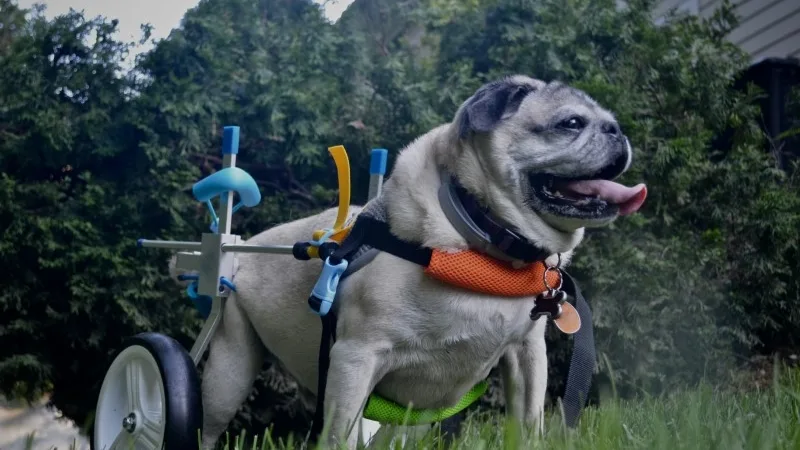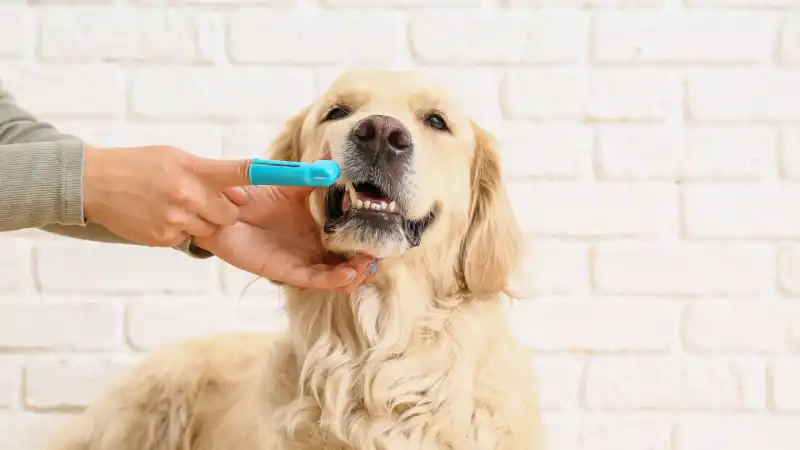Natural Remedies for Hip Dysplasia in Dogs
Hip dysplasia is a painful hereditary condition for dogs, but there are ways to keep your pup comfortable. Here are 8 ways to naturally treat hip dysplasia in dogs.

If you're the owner of a large breed dog, you've likely had a conversation with your veterinarian about the signs and symptoms of hip dysplasia. This hereditary condition most commonly affects German Shepherds, Golden Retrievers, and Labrador Retrievers, but it can actually happen in any breed of any size.
Dogs grow rapidly for the first year of their life. During this growth stage, some dogs' hip joints may not develop properly, leading to hip dysplasia. When this happens, the ball and socket of the hip joint rub together, leading to the deterioration of the joint over time.
While this hereditary condition can be painful for your pup, there are ways that you can help your dog feel more comfortable and treat hip dysplasia naturally. Let's take a look at 8 ways to do just that.
8 Ways to Naturally Treat Hip Dysplasia in Dogs
While surgery is an option, if the hip dysplasia is not severe enough, your vet will likely recommend starting with natural treatments first. Here are 8 ways you can naturally treat hip dysplasia in your dog.
1. Modify Your Dog's Diet
Controlling your dog's weight is one of the most important things you can do for a dog with hip dysplasia. The more overweight your dog is, the more pressure is put on their joints, leading to pain and discomfort.
Talk with your vet about a weight management plan for your dog. This plan may include switching your dog's food to a higher-quality, fresher diet, or incorporating more human foods into your pup's meals.
Some human foods are higher in vitamins and minerals that help reduce inflammation in your dog's joints. These include:
Blueberries
Turmeric
Fish and other foods rich in Omega-3 fatty acids
Ginger root
Spinach
Pumpkin
2. Physical Therapy
Physical rehabilitation can help dogs with hip dysplasia improve the range of motion in their hips, increase their mobility, build or maintain muscle mass, and ease the pain.
Your vet can work with your dog on a variety of passive and active stretches, massages, and range-of-motion exercises to support their muscles and help strengthen the hip joints. They will also work with you to create a customized treatment plan to follow at home.
3. Hydrotherapy
Your veterinarian can use a variety of physical therapy techniques to help improve your dog's mobility, but one of the most popular techniques is hydrotherapy.
With hydrotherapy, your dog exercises inside of a swimming pool or using an underwater treadmill. The water reduces the amount of pressure placed on your dog's joints, allowing them to exercise their hip joints and leg muscles without the usual discomfort.
Hydrotherapy is a great way for your dog to regain mobility, and it's also a fantastic way to help them lose weight.
4. Natural Supplements and Herbs
In addition to feeding your dog a healthier, more balanced diet, you can also make use of natural supplements to help reduce joint inflammation.
Glucosamine and chondroitin are common ingredients used in joint supplements. They are naturally occurring compounds that have been shown to alleviate joint damage, maintain joint fluid thickness, and boost cartilage repair in dogs.
While there's still a lack of veterinary research on these two compounds, one study by the Journal of the American Veterinary Medical Association found that glucosamine provided a moderate level of comfort for dogs on par with some prescription drugs.
Other supplement ingredients that have shown promising results with joint pain and inflammation include:
Omega-3 fatty acids supplements
Licorice
Ginger
Alfalfa
Rosemary
5. Use a Special Mattress
For dogs with hip dysplasia, sleeping can be uncomfortable at times and put unnecessary pressure on their joints. An orthopedic dog bed can help your dog sleep more comfortably and reduce the amount of pain they feel when resting.
Orthopedic dog beds are made from memory foam, and they're designed to distribute pressure evenly across your dog's entire body. This takes the pressure off the joints, relieving pain and helping your dog rest more easily.
Placing rugs on hard surfaces throughout your home can also help make moving around easier for your pup. And cushioned stairs can help them access your couch or bed without needing to jump.

Every Dog and Cat Deserves the Pet Insurance of Champions
Get prize-winning care for your pets.
6. Moderate Exercise on Soft Surfaces
Exercise is vital for controlling your dog's weight and keeping their muscles active. While running and intense exercise can contribute to joint pain and inflammation, walking on a soft surface like grass or sand can be the perfect workout for your dog.
Walking up hills can even help increase muscle development and improve your dog's overall mobility. So, next time you take your dog for a walk, find a hilly route to really give their legs (and hips) a workout.
7. Heat Treatments
Just like in humans, heat can help loosen your dog's muscles and improve the blood flow into their joints.
One great way to apply heat to your dog's hip joints is by using hot water bottles or a heated towel. Gently apply the hot water bottle or heated towel to your dog's hip or other places where they're experiencing pain for a few minutes every day, especially before bed.
A warm bath is also a great way to soothe your dog's aching joints. Make sure that the bath, water bottle, or hot towel is never too hot for your dog to touch. And discontinue use immediately if they react painfully to any of the heat treatments.
8. Chiropractic Treatments
Many dog owners have found success using chiropractic massages and acupuncture treatments to help reduce their dog's pain.
Acupuncture can stimulate your dog's natural release of pain-relieving and anti-inflammatory chemicals. Along with massages, it can also improve your dog's blood flow and circulation, as well as the removal of metabolic wastes and toxins from the body.
Which Natural Remedy Is Right for Your Dog?
Some or all of these remedies can help dogs with hip dysplasia relieve their joint pain and strengthen their muscles. Not all remedies will be right for every dog, however, so it's important to start with one or two and see how your dog responds.
Always talk with your vet before making any changes to your dog's daily routine. They can help you create a custom treatment plan to keep your dog happy, healthy, and comfortable. With a little patience and consistency, you can help alleviate your dog's hip dysplasia pain and improve their quality of life.
The Hereditary Coverage add-on from AKC Pet Insurance (underwritten by Independence American Insurance Company) offers reimbursement for eligible treatments related to hip dysplasia and many other congenital conditions.

Every Dog and Cat Deserves the Pet Insurance of Champions
Get prize-winning care for your pets.

Richard has shared his life with pets since childhood, and currently has a rescue cat and dog. He works with veterinarians and pet businesses to improve their content. To find out more, please visit his [website](https://richardrowlands.com/).
READ MORE ARTICLES

